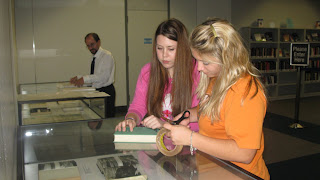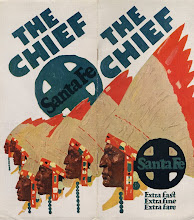Tuesday, December 22, 2009
Friday, December 18, 2009
DONATION OF RARE HUGO GELLERT PORTFOLIO TO THE WOLFSONIAN LIBRARY
We are delighted to be able to recognize the donation of an extraordinarily rare oversized portfolio to the Wolfsonian library collection by Elinor Brecher of Miami, Florida. Entitled, Century of the Common Man: two speeches by Henry A. Wallace, this portfolio contains double-page plates with excerpts of Vice President Henry Wallace’s speech and full-page silk-screened illustrations on the facing pages drawn by artist/activist Hugo Gellert (American, born in Hungary, 1892-1985). The portfolio was published in a limited edition of fifty-four, numbered and autographed by the artist. Hugo Gellert was an unabashedly outspoken member of the Communist Party of the United States of America and he lent all of his artist talents to championing that political cause.
This particular portfolio was published during the brief period of cordial U.S.-Soviet relations following the German invasion of Russia during the Second World War. After the invasion, Stalin deemed it expedient to seek the support of any and all left-leaning, liberal and "Popular Front" groups arrayed against the fascists. This latest donation joins two other oversized portfolios illustrated with lithographs by Gellert: Karl Marx Capital in Pictures and Comrade Gulliver: an Illustrated Account of Travel into that Strange Country the United States of America. These poster-sized portfolios comprise three of some thirty-four Gellert titles in our library. Several of his works were exhibited in a display organized by two Florida International University students last fall, and can be seen on line in a virtual display of their exhibition presently on view on the second floor of the Green Library on the Modesto Maidique Campus or accessible at the following web address:
http://www.librarydisplays.wolfsonian.org/Great%20Depression/GD%20displays.htm
Our thanks go out to Elinor Brecher for her generosity in donating this wonderful portfolio. As a repository with a wide range of Gellert materials in our collection, we hope to be able to organize an exhibition sometime in the future that will make these materials presently available to visiting scholars in our library, accessible to the general public visiting our galleries as well.
Wednesday, December 16, 2009
HAPPY HOLIDAYS FROM THE WOLFSONIAN-FIU LIBRARY
LIBRARY OBJECT(S) OF THE WEEK
Friday, December 11, 2009
RECEPTION FOR FIU STUDENT-CURATED EXHIBIT IN GREEN LIBRARY
At the close of the reception, the student curators were presented with tee shirts from the museum gift shop and copies of the poster for the exhibit created by the Wolfsonian’s own art director, Tim Hossler.
My special thanks to Laura Probst and Vicki Silvera for their support in providing the display space for this exhibition and for putting this reception together and providing refreshments. We look forward to working together with Vicki in planning some new collaborative exhibition projects.
Thursday, December 10, 2009
COLLECTIONS CARE AND PREVENTIVE CONSERVATION ASSESSMENT
Although the library does not presently have the trained staff or resources to undertake aggressive conservation treatments of some of the fragile and brittle works in the collection, we have been actively moving forward with a collection stabilization program. Given our location in the subtropics, donations and new acquisitions are screened for evidence of bookworm and silverfish activity. Suspect items are isolated and frozen in a special low-temp freezer at our off-site annex to prevent the possible transfer of insect infestations to the library. Library interns and volunteers have also been trained to create archival-quality, custom-fit Melinex sleeves for the delicate ephemera in the library collection using an ultrasonic polyester encapsulation machine put together on the premises by inventor William Minter a couple of years ago. This rather expensive machine—(partially funded by a generous Capital Development grant from Miami Dade County’s Department of Cultural Affairs)--has allowed us to produce inexpensive enclosures that provide brittle items with added tensile strength and protect them from the oils naturally found on our fingers. We have also recently ordered archival drop front storage boxes in order to re-house and better preserve the thousands of cruise ship industry promotional materials recently added to our collection by the donation of Dr. Laurence Miller.
Saturday, December 5, 2009
THEY DID NOT DIE!
Monday, November 30, 2009
VISIT BY HISTORY OF GRAPHIC DESIGN CLASS

After viewing some Futurist and Constructivist masterpieces by Fortunato Depero (1892-1960) and El Lissitsky (1891-1941), the class ended their tour with an examination of some advertising designs from an archive of Herbert Bayer (1900-1985). Bayer, a student of the Weimar Bauhaus, became a prominent graphic designer in Berlin, and, after moving to the United States in 1938, organized the “Bauhaus 1919-1928” exhibition at the New York Museum of Modern Art and an important exponent of the New Bauhaus school in America. 
Thursday, November 26, 2009
ALPHABET SOUP STUDENT EXHIBIT INSTALLED IN FIU'S GREEN LIBRARY

One of the students, Mariana Clavijo, selected materials from two of President Franklin Delano Roosevelt’s earliest New Deal programs: the NRA and AAA. (It goes without saying that Ms. Clavijo was not interested in either the National Rifle Association or the American Automobile Association). Rather, she used her display to investigate how the National Recovery Administration and the Agricultural Adjustment Administration promoted their plans, and to determine if the reforms actually succeeded in providing real relief to industrial and farm workers hit hard by the Great Depression.
Several of the student curators decided to focus on the Federal Arts Project (FAP, or Federal One). Jessica Tejeiro, for example, chose to display exhibition catalogs and programs for works of art exhibited in federally-funded community art centers and galleries. She also tapped into an archive of official documents and correspondence of Robert Delson, head of the Florida Arts Project in Jacksonville, and illustrator of the Florida Guide.
A Powerpoint presentation will also be running on the large flat screen monitor in the exhibit area featuring the displays put together by FIU students who opted to do this curatorial project Fall semester 2008. Although this year’s installation came off without a hitch, there was some unexpected excitement during the student-guided tours that followed. Just as Ms. Kashem was pointing out a board game and talking about the forest fire prevention and suppression activities of the CCC, the Green Library’s fire alarms went off! Fortunately, after a fifteen-minute “recess,” the class reassembled and the tour resumed.
We hope to be able to organize a public reception where the the student curators will again have the opportunity to give guided tours and speak about their curatorial experience with Wolfsonian museum founder, Mitchell Wolfson, Jr. in attendance. This event is likely to take place sometime in the late afternoon or early evening, Thursday December 10th. Details to follow!
Wednesday, November 25, 2009
FIU ARCHITECTURE STUDENTS TO CONTEMPLATE A POSTCARD MUSEUM
Saturday, November 21, 2009
GREAT EXPECTATIONS! NEW AND PENDING ARRIVALS!
Monday, November 16, 2009
VISIT BY HIALEAH GARDENS HIGH SCHOOL STUDENTS
Today, this project included for the first time a visit by high school students who will serve as mentors for this year’s round of fifth graders. Twenty-three Hialeah Gardens High School students came to the library for an hour and a half presentation covering the history of the book, and an up-close look at some rare and unusual bindings in our collection, including: a Japanese scroll book and accordian-style book, an elephant portfolio of lithographs by Rembrandt, a papier-mâché contoured binding by the Wiener Werkstatte, several Futurist and Constructivist masterpieces, and some quirky sales catalogs and cookbooks. They also had the opportunity to look at some of the collaborative book projects produced by students participating in the program in years past.
Pictured above are a few of the unusual bindings they had the opportunity to review.
Friday, November 13, 2009
WOLFSONIAN PROFILE: LIBRARY VOLUNTEER, ARMANDO SUAREZ
One such individual is Armando Suarez. A native of Madrid, Spain, Mr. Suarez has been working full-time for the Wolfsonian as a financial and administrative assistant since November 2007. Those duties have not deterred him from coming in on his free days to work with us here in our rare books and special collections library. Armando has provided us with invaluable assistance in processing and accessioning several recently-acquired collections, cataloging the same in MARC21, making Melinex enclosures for rare and delicate items using our ultrasonic polyester welding machine, and creating digital images of our ephemeral items and linking those images to the catalog records in our OPAC.
Wednesday, November 11, 2009
SOME THOUGHTS FOR THE VETERANS DAY HOLIDAY
But the treatment of America’s veterans has a far longer and tumultuous tradition than the history of the holiday might imply. In fact, one of the very first rebellions faced by the newly-formed American Republic, (Shays Rebellion), took its name from the former Revolutionary war veteran who led a band of discontented veterans to demand a redress of their grievances. Many revolutionary war soldiers had been conscripted, fought without pay, and had been shabbily-treated upon discharge, including being locked up in debtor’s prison. In response to high taxes, confiscations, and foreclosures of their family farms, more than a thousand former soldiers banded together in 1786-1787, occupying county courthouses in Western Massachusetts to forestall property seizures. When their petitions to the Massachusetts governor were ignored and their leaders threatened with “treason,” the veterans attempted to seize the federal arsenal at Springfield, but were routed with some casualties, and their militia soon after disbanded and their leaders slipped away or were arrested.

















































